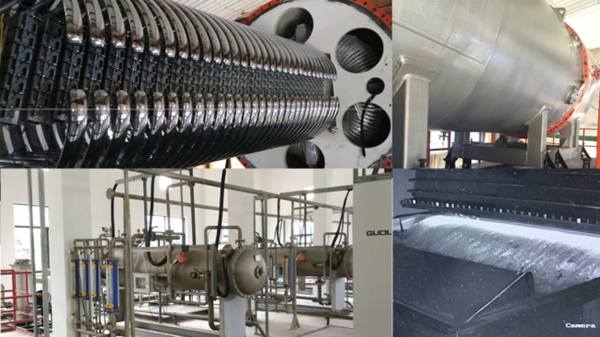

 |
| Electron beam technology is used to clean industrial wastewater at a textile dyeing facility in Jinhua city, 300 kilometers south of Shanghai. (Photo: Nuclear and Energy Technology Institute, Tsinghua University, Beijing.) |
Recently, China debuted its first wastewater treatment facility to use electron beams, ushering in a new era for radiation technology, according to an IAEA press release.
Bacteria are the workhorses of wastewater treatment, as they digest and break down pollutants. Wastewater from textile dyeing, however, contains molecules that cannot be treated with bacteria. To color textiles, compounds with large, long and complex chains are used, meaning that wastewater from the industry can contain more than 70 complex, hard-to-degrade chemicals.
Nevertheless, by irradiating the waste that flows into the water supply using electron beams, scientists are able to break these complex chemicals into smaller molecules, which can in turn be treated and removed using normal biological processes. Irradiation is done using short-lived reactive radicals than can interact with and break down a wide range of pollutants.
“The radiation treatment technology does not add additional chemical reagents, and is listed as the main research direction of Peaceful Uses of Atomic Energy of the Century by [the International Atomic Energy Agency], as it offers a rapid response and high efficiency,” said Yu Jiang, general manager of CGN Dasheng Electron Accelerator Technology Co. Ltd., which cooperates on the project with the Nuclear and Energy Technology Institute at Beijing's Tsinghua University.
“Despite advances in conventional wastewater treatment technology in recent years, radiation remains the only technology that can treat the most stubborn colorants in wastewater,” said Sunil Sabharwal, Radiation Processing Specialist at the IAEA. “The problem is that the technology exists in developed countries, while most of the need now is in the developing world.”
To bridge the knowledge gap, the IAEA ran a coordinated research project on the technology, including its transfer to several countries, mostly in Asia.
At present, the new plant, which is located in the city of Jinhua, 300 kilometers south of Shanghai, treats 1,500 cubic meters of wastewater on a daily basis. Chinese researchers are also considering the use of electron beam technology to treat residue from pharmaceutical plants, paper mills, chemical plants and other industrial parks with complex water treatment needs.
 Fire brigade in Shanghai holds group wedding
Fire brigade in Shanghai holds group wedding Tourists enjoy ice sculptures in Datan Town, north China
Tourists enjoy ice sculptures in Datan Town, north China Sunset scenery of Dayan Pagoda in Xi'an
Sunset scenery of Dayan Pagoda in Xi'an Tourists have fun at scenic spot in Nanlong Town, NW China
Tourists have fun at scenic spot in Nanlong Town, NW China Harbin attracts tourists by making best use of ice in winter
Harbin attracts tourists by making best use of ice in winter In pics: FIS Alpine Ski Women's World Cup Slalom
In pics: FIS Alpine Ski Women's World Cup Slalom Black-necked cranes rest at reservoir in Lhunzhub County, Lhasa
Black-necked cranes rest at reservoir in Lhunzhub County, Lhasa China's FAST telescope will be available to foreign scientists in April
China's FAST telescope will be available to foreign scientists in April "She power" plays indispensable role in poverty alleviation
"She power" plays indispensable role in poverty alleviation Top 10 world news events of People's Daily in 2020
Top 10 world news events of People's Daily in 2020 Top 10 China news events of People's Daily in 2020
Top 10 China news events of People's Daily in 2020 Top 10 media buzzwords of 2020
Top 10 media buzzwords of 2020 Year-ender:10 major tourism stories of 2020
Year-ender:10 major tourism stories of 2020 No interference in Venezuelan issues
No interference in Venezuelan issues
 Biz prepares for trade spat
Biz prepares for trade spat
 Broadcasting Continent
Broadcasting Continent Australia wins Chinese CEOs as US loses
Australia wins Chinese CEOs as US loses